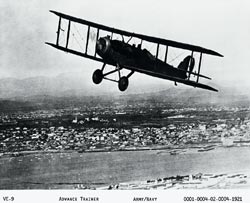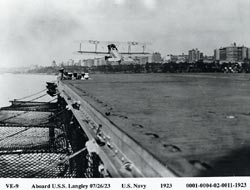|
 The failure of the VE-8 prompted Chance to work on improving the VE-7 to ensure continued business. In his methodical way, he came up with the VE-9. Equipped with a Wright E-3 180-hp engine , the new airplane provided more speed and a few refinements over the VE-7. Some VE-9’s had the Wright Hisso E-4 220-hp engine. The rudder and tail designs were changed to compensate for this added power. Between the VE-7 and VE-9, the major system differences were in the fuel and oil systems, one difference being that the two fuel tanks on the VE-9 were interconnected. The failure of the VE-8 prompted Chance to work on improving the VE-7 to ensure continued business. In his methodical way, he came up with the VE-9. Equipped with a Wright E-3 180-hp engine , the new airplane provided more speed and a few refinements over the VE-7. Some VE-9’s had the Wright Hisso E-4 220-hp engine. The rudder and tail designs were changed to compensate for this added power. Between the VE-7 and VE-9, the major system differences were in the fuel and oil systems, one difference being that the two fuel tanks on the VE-9 were interconnected.
The Army purchased 27 VE-9’s as replacements and the Navy placed an initial order for 21. The first Navy delivery was on June 24, 1922. Two Navy versions were built, the landplane (VE-9) and seaplane (VE-9H). Later, when the VE-9 model was further developed by the Navy, it was standardized for advanced training and gunnery purposes. It was further developed into the convertible type and used as the original catapult aircraft for observation and gunnery-spotting.  When the U.S.S. Langley (the Navy’s first aircraft carrier) was commissioned, it was equipped exclusively with VE-9’s fitted with arresting gear for deck landings. When the U.S.S. Langley (the Navy’s first aircraft carrier) was commissioned, it was equipped exclusively with VE-9’s fitted with arresting gear for deck landings.
The VE series led an active service life in the Army Air Service, Navy, and USMC until 1928. A number of ex-Air Service VE’s continued to be useful with the Treasury Department’s Prohibition Service, where they were used for border patrol.
|